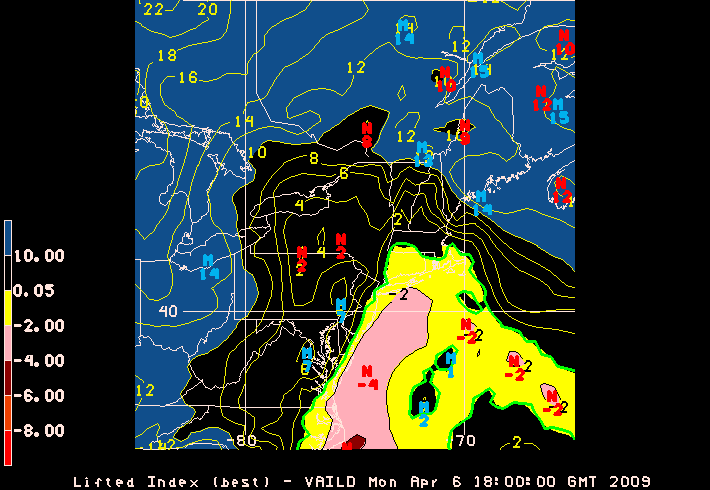Lifted index on:
[Wikipedia]
[Google]
[Amazon]
 The lifted index (LI) is the
The lifted index (LI) is the
Lifted Index
( University of Illinois)
A look at LI
Convective indices
(NWS St. Louis)
AMS Glossary stability indices, including LI
* {{Meteorological variables Severe weather and convection Atmospheric thermodynamics
 The lifted index (LI) is the
The lifted index (LI) is the temperature
Temperature is a physical quantity that quantitatively expresses the attribute of hotness or coldness. Temperature is measurement, measured with a thermometer. It reflects the average kinetic energy of the vibrating and colliding atoms making ...
difference between the environment Te(p) and an air parcel lifted adiabatically Tp(p) at a given pressure height in the troposphere
The troposphere is the lowest layer of the atmosphere of Earth. It contains 80% of the total mass of the Atmosphere, planetary atmosphere and 99% of the total mass of water vapor and aerosols, and is where most weather phenomena occur. From the ...
(lowest layer where most weather occurs) of the atmosphere
An atmosphere () is a layer of gases that envelop an astronomical object, held in place by the gravity of the object. A planet retains an atmosphere when the gravity is great and the temperature of the atmosphere is low. A stellar atmosph ...
, usually 500 hPa ( mb). The temperature is measured in Celsius. When the value is positive, the atmosphere (at the respective height) is stable and when the value is negative, the atmosphere is unstable.
Determining LI
LI can be computed using computer algorithms but can also be determined graphically. To do this, generally, the parcel is lifted from the portion of the planetary boundary layer (PBL) that lies below the morning inversion. The air here should be about 60 to 65% RH, which is then lifted along the dry adiabat (see alsoadiabatic process
An adiabatic process (''adiabatic'' ) is a type of thermodynamic process that occurs without transferring heat between the thermodynamic system and its Environment (systems), environment. Unlike an isothermal process, an adiabatic process transf ...
) to the lifting condensation level (LCL), which is the intersection of that curve with the average mixing ratio in the boundary layer. Once the LCL is found, the parcel is lifted along the moist adiabat to 500 mb. It is then that one finds LI = Te(p) - Tp(p).
LI is generally scaled as follows:
* LI 6 or Greater, Very Stable Conditions
* LI Between 1 and 6 : Stable Conditions, Thunderstorms Not Likely
* LI Between 0 and -2 : Slightly Unstable, Thunderstorms Possible, With Lifting Mechanism (i.e., cold front, daytime heating, ...)
* LI Between -2 and -6 : Unstable, Thunderstorms Likely, Some Severe With Lifting Mechanism
* LI Less Than -6: Very Unstable, Severe Thunderstorms Likely With Lifting Mechanism
Significance to thunderstorms
The lifted index can be used in thunderstorm forecasting, however, convective available potential energy (CAPE) is considered by most as a superior measurement of instability and is preferred by many meteorologists for convection forecasting. However, LI is easier and faster to determine without using a computer, as determining CAPE requires integration from one level to another.See also
* Atmospheric convection *Atmospheric thermodynamics Atmospheric thermodynamics is the study of heat-to-Work (physics), work transformations (and their reverse) that take place in the Earth's atmosphere and manifest as weather or climate. Atmospheric thermodynamics use the laws of classical thermodyn ...
* Convective instability
* Lapse rate
References
External links
Lifted Index
( University of Illinois)
A look at LI
Convective indices
(NWS St. Louis)
AMS Glossary stability indices, including LI
* {{Meteorological variables Severe weather and convection Atmospheric thermodynamics